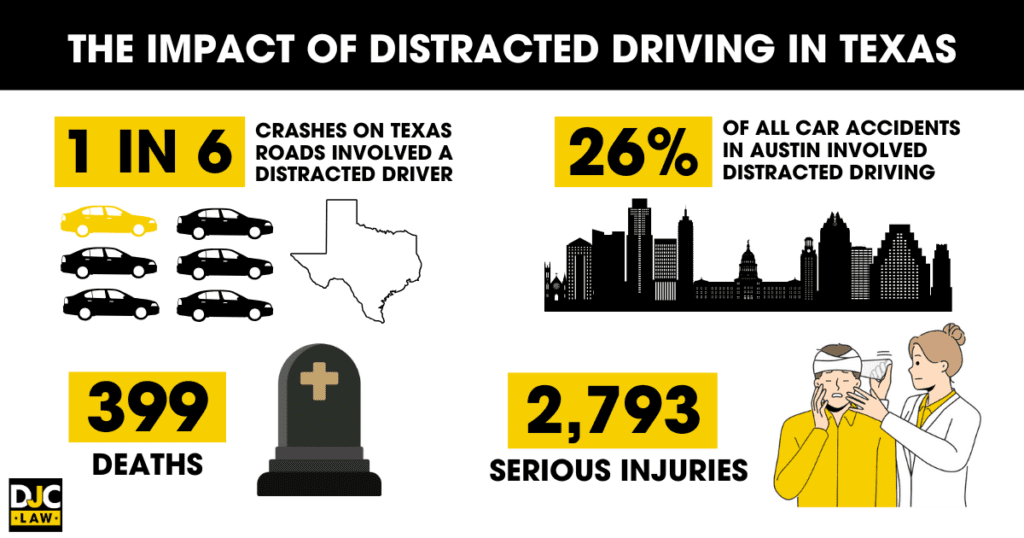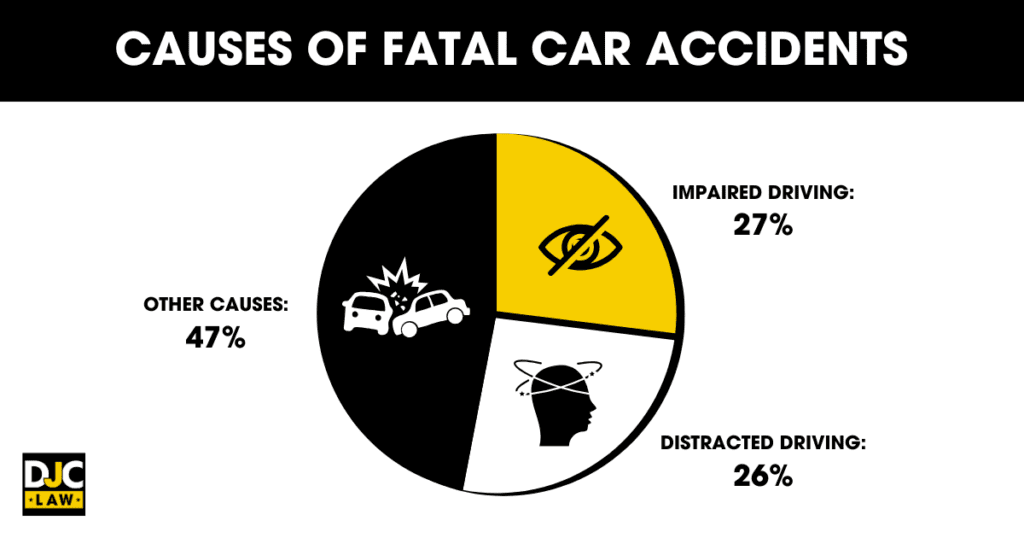Assisting Personal Injury Victims in the Pursuit of Justice and Financial Compensation Across Central Texas
Car accidents are one of the leading causes of death in Texas. Car crashes happen in the blink of an eye. Someone may be driving down the road and going about their day when the negligence of another person changes their life. Accidents can lead to serious injury, medical bills, missed time from work, pain, suffering, and other economic or non-economic damages.

Getting compensation for your losses involves dealing with the insurance company of the other driver, which is never a good idea to do without legal guidance. Contacting a skilled Austin car accident lawyer immediately is important for one who has been injured in an auto wreck. If you’ve been injured in a car accident, reach out to our team of personal injury attorneys today.
Car accidents can happen in a blink of an eye, and unfortunately, car accidents are one of the leading causes of death in Texas.
As it sometimes happens, you are going about your day in your car when suddenly, your life is changed because someone was negligent.
Auto accidents often lead to serious injuries, medical bills, missed time from work, pain and suffering, as well as other damages. Getting compensation for your losses involves dealing with the other driver's car insurance company, which is never a good idea to do without legal guidance.
Contacting a skilled Austin car accident lawyer immediately after an accident is important. An attorney will protect your rights, help you with the paperwork, and help find the right doctors.
Additionally, a lawyer will communicate with the auto insurance company on your behalf so you can focus on healing.

Litigating Car Crash Cases in Austin with a Lawyer's Help
Unfortunately, car accidents are a common roadway occurrence in Austin. On average, there are over 6 million car accidents in the U.S. annually.
If you are in a vehicle, a car crash can happen at any time, so it’s important to know what to do if you are involved in one. Read on to learn more about what to expect after an auto accident and the eight immediate steps you should take.
What Are Common Causes of Car Accidents in Austin?
Several factors can cause car crashes. While some auto accident cases may seem self-evident, others are more complicated and require a thorough investigation to determine the cause of the crash and prove liability.

Among the most common causes of car crashes in Austin, TX, are the following:
- Adverse weather conditions
- Defective or malfunctioning equipment
- Distracted driving and driver inattention
- Driver fatigue and drowsy driving
- Driving while intoxicated or under the influence of drugs
- Eating, drinking, personal grooming, and adjusting the stereo controls while driving
- Failing to signal or check mirrors before merging
- Failure to yield to the right of way
- Illegal turns
- Lane splitting
- Poor road conditions
- Potholes and tire blowouts
- Reckless driving or aggressive driving
- Reversing without looking
- Running stop signs and red lights
- Speeding
- Tailgating or driving too closely behind the lead vehicle
- Talking on a cell phone while driving you
- Texting while driving
- Unsafe lane changes
- Wrong way driving
- And more
Whatever the cause of your auto accident, if you or your passengers have suffered severe injuries, you should not be the ones responsible for the costly medical bills. As your legal representatives, our Austin car accident lawyers will endeavor to fight for your rights in pursuit of the most optimal outcome for your injury case. To learn more about our legal services, contact our Texas auto accident lawyers to schedule your free consultation today.
What Are the Most Common Injuries after a Car Crash?
Injuries from a car crash can be debilitating and affect you for years. Injuries sustained in a car accident can keep you out of work, decrease the quality of your life, and leave you with serious medical debt.
The most common injuries sustained in local auto accidents include:
- Whiplash
- Traumatic Brain Injuries (TBI)
- Fractures
- Spinal Cord Injuries
Where do Most Auto Accidents in Austin Occur?
According to city officials, these four intersections are the most accident-prone in Austin:
- I-35 service road & Martin Luther King Jr. Boulevard
- U.S. 183 service road & Cameron Road
- North Lamar Boulevard, between Rutland Drive & Rundberg Lane
- North Lamar Boulevard & Parmer Lane
If you have questions about what to do after a car accident, consult with one of our experienced car accident attorneys in Austin.
Why You Should Hire an Austin Auto Accident Attorney
Car crash victims can often receive financial compensation for their injuries. Under Texas law, whether you can receive compensation will depend on fault — in other words, who is responsible for the accident.
Imagine you were driving down the road when someone speeding in the other direction pulls into your lane to illegally pass someone. You don’t have time to swerve and you hit the vehicle head-on. In this example, the driver who pulled into your lane illegally is at fault, because he did not pass with sufficient care.
If you are in an auto accident in Austin, it’s important to find a knowledgeable car crash attorney who understands the complexities of Texas law and can help guide you through the process. A skilled lawyer will protect your rights and make sure that every step of communicating with insurance companies is done correctly. They will also ensure that you receive fair compensation for your injuries, pain and suffering, lost wages, and any other damages incurred as a result of the accident.
What is Modified Comparative Negligence?
Texas is a modified comparative negligence state for car accidents. This legal doctrine allows for the division of blame among several parties involved in an auto accident. That means that even if you share a certain amount of fault for causing the crash, you may still have the right to recover compensation.
If you were partially responsible for causing the crash, your compensation will be reduced accordingly. For example, if a judge finds that you were 30% at fault for the car accident, your recoverable economic and non-economic damages would be reduced by 30%. For those fighting for the maximum compensation, it is crucial to establish that you were not in the wrong and that all fault rests on the shoulders of the other motorists.
Negligence laws vary wildly by state, so you must speak with a car accident lawyer in Texas for accurate information on your case. Under our modified comparative negligence system, if you were more than 51% at fault for the personal injury accident, state law prohibits you from recovering any form of compensation.
The car accident lawyers of our Austin law firm have years of experience representing clients in complex personal injury cases. An Austin car accident lawyer will do everything possible to potentially minimize your assigned fault, thus maximizing the compensation you stand to recover. To learn more about how a Texas car accident attorney could assist you with your case, please get in touch with us to schedule your free, no-obligation case evaluation today.
Establishing Fault for an Auto Accident
Not all accidents are clear cut in terms of liability. In some accidents, like a sideswipe, either vehicle might be to blame. Insurers will sometimes argue about fault because they can eliminate or reduce the amount they pay you if you share some of the blame for the crash.
Your traffic accident lawyer can find the evidence necessary to show that another driver is to blame. Your lawyer can:
- Review the police report
- Find surveillance video if your accident happened in a parking or lot or near a business
- Help you record your own memories of what happened
- Interview witnesses to the crash
- Analyze medical records
- Inspect the damage to your vehicle
With this evidence, your Austin lawyer can try to reconstruct what happened and present a coherent story to the insurance companies explaining that the other driver is at fault for the car wreck.

Negotiating on Your Behalf
If the insurance company accepts that its insured is responsible for the crash, then you will need to negotiate a settlement, which should cover all your losses in your accident case. Many of our clients need compensation for:
- Past and future medical care
- Lost income and future earning capacity
- Property damage, such as damage to their vehicles
- Past and future pain and suffering
Some insurers play hardball by making a very low, initial offer, hoping you will accept out of desperation.
Many of our clients are too hurt to work and need money to cover bills, so they feel pressured to accept the first settlement.
As experienced Austin car injury attorneys, we can properly value your injuries. Then, we can negotiate with an insurer for compensation on your behalf. Negotiation involves a tense back and forth, but we know the tricks that insurers use to try to minimize their legal liability.
Does Texas Follow a No-Fault Policy?
Texas operates under a traditional fault-based insurance system rather than a no-fault policy. This means that, after an accident, the individual deemed responsible for causing the accident is liable for any injuries and damages incurred. In Texas, drivers are required to carry liability insurance, which provides coverage for bodily injury and property damage caused to others in an accident for which the insured driver is at fault.
While no-fault insurance systems allow individuals to file claims with their own insurance companies regardless of who was at fault, Texas holds back on such arrangements. This could be seen as both advantageous and disadvantageous. On the positive side, victims may seek full compensation from the at-fault party, potentially covering medical bills, lost wages, and pain and suffering. However, this can also complicate the claims process, as proving fault can lead to disputes between insurance companies and may involve lengthy negotiations.
In practice, if you are involved in a car accident in Texas, it's crucial to document the situation thoroughly and consider legal representation. This can help ensure you receive the compensation to which you are entitled, especially in cases involving complex liability issues or significant injuries.
Can a Personal Injury Lawyer Represent Cases Involving Fatal Car Accidents in Austin, TX?

Motor vehicle accidents tragically killed many people on the highways and roads across the state of Texas. Among the most dangerous areas for fatal car accidents include Interstate access points, intersections, and neighborhood roads not far from your home.
Whereas in a personal injury case, the injured victim would be able to file a claim on their own, in a wrongful death case, someone must file the legal action on their behalf. In Texas, the decedent's spouse, children, or parents have the right to file a wrongful death lawsuit against the fault parties. Suppose none of those individuals file a wrongful death action within three months of the death. In that case, the personal representative of the estate may file a wrongful death lawsuit, provided all interested parties do not object.
While we are a personal injury law firm, our attorneys have extensive experience representing grieving families filing wrongful death lawsuits against liable parties. If another person's negligence or recklessness caused a car crash, you may have the grounds for a wrongful death claim. By filing your claim, you stand a chance of recovering financial compensation.
Having an experienced attorney in your corner throughout the wrongful death claims process is highly recommended. Your attorneys can gather evidence, negotiate with insurance companies, and assist you throughout the legal process to help you get justice and financial recovery.
A wrongful death lawsuit must be filed within two years of the loved one's death. If you miss the two-year window, your wrongful death case may be dismissed. There are certain exceptions to the two-year statute of limitations, and to learn more, we advise you to contact our Austin law office to schedule your free initial consultation with our legal team.
Mistakes to Avoid After an Auto Accident

After being involved in a car accident, it's understandable that you may feel overwhelmed and unsure of what to do next. However, there are certain mistakes you should try to avoid, which can help protect your legal rights and improve your chances of receiving fair compensation for your injuries and damages.
- Admitting Fault: It's natural to want to apologize or take responsibility after an accident, but insurance companies can use this against you. Instead, stick to the facts when speaking with others at the scene. Plus, fault is often not immediately clear and may be determined by a thorough investigation.
- Not Seeking Medical Treatment: Even if you feel fine after the accident, it's important to seek medical attention as soon as possible. Some injuries may not have immediate symptoms, and having documentation of any potential injuries can support your case.
- Failing to Gather Evidence: Be sure to take photos of the accident scene, damage to vehicles, and any visible injuries. Also, contact information from witnesses should be gathered, and insurance information should be exchanged with the other driver(s).
- Not Contacting a Lawyer: Insurance companies may try to pressure you into accepting a low settlement, but having a lawyer on your side can help ensure you receive fair compensation for your losses.
- Talking to Insurance Adjusters: It's best to avoid speaking with insurance adjusters without your lawyer present, as they may try to use your words against you. Let your lawyer handle all communication with the insurance company on your behalf.
By avoiding these common mistakes, you can protect your legal rights and increase the chances of receiving a fair settlement for your car accident.
Helping You Avoid Mistakes
Some accident victims hamstring their cases by doing the following:
- Giving a recorded statement to the insurance company when they are not feeling well and not thinking clearly.
- Failing to keep adequate documentation of their injuries and their financial losses.
- Settling without properly reviewing a settlement.
At DJC Law, our team will help you avoid making these mistakes. Instead, we will handle the case from start to finish and take care of all communications with the insurer.
We will also handle all negotiations. If the liable party's insurance does not offer a full and fair settlement, we are prepared to march into court to file a personal injury lawsuit for the compensation that you need and deserve.
Get Help From Our Austin Car Accident Attorneys Today
If you or your loved one suffered injuries as a result of an auto collision, we are here to help. At DJC Law, our Austin car accident lawyers will fight to get you fair compensation for your losses. For a free review of your case, please contact us today.
If you’ve been in a car accident that was not your fault, a lawyer might be able to help you receive more compensation than you would on your own. This is especially true if you incurred a serious injury from the accident, resulting in medical bills, potentially time lost from work, as well as mental and emotional anguish.
Even if your injury wasn’t severe but, let’s say, your car was totaled, a personal injury lawyer can help you file a claim with the at-fault driver’s insurance company or your insurance company (or both).
An insurer’s goal when speaking to someone who has filed a claim is to reduce what they have to pay you, so having a lawyer supporting this effort can help you receive the compensation you deserve. The personal injury settlement for car accidents varies greatly depending on the situation.
Rather than looking for a catchall average, you’ll have better luck working with a lawyer to help calculate what type of compensation you’re entitled to. For more information on how these calculations are made, check out this personal injury settlement calculator.
The Texas statute of limitations for filing a personal injury lawsuit after a car accident is up to two years from when the accident occurred. This applies to pedestrians, drivers, passengers, and motorcyclists.
In many cases, victims of car accidents don’t fully understand the extent of their injury until some time has passed, as medical bills pile up and conditions, in some instances, worsen. It’s not uncommon to file a lawsuit at any point within the range of these two years.
The amount of compensation you ask for after being in a car accident very much so depends on the severity of the accident and the injuries you suffered. When discussing “pain and suffering” as it relates to personal injury claims, it’s a catch-all term that refers to the non-financial losses you suffered (i.e. excluding medical bills, car repair costs, etc.). If your losses extend beyond financial losses, there’s a strong possibility you deserve compensation for “pain and suffering.”
A personal injury attorney can help you quantify that amount, as well as fight to ensure you receive it.
Tips for Avoiding Car Accidents
Driving safely is essential in minimizing the risk of accidents. Here are some key tips to help you stay safe on the road:
- Stay Focused: Avoid distractions like mobile phones, loud music, or eating while driving. Keep your attention on the road and your surroundings at all times.
- Follow Speed Limits: Adhering to speed limits is crucial for your safety and that of others. Adjust your speed based on road conditions and traffic flow.
- Maintain a Safe Distance: Always keep a safe following distance between your vehicle and the one ahead. This ensures ample time to react in case of sudden stops.
- Use Turn Signals: Always signal your intentions to other drivers when changing lanes or turning. This helps improve communication and decreases the likelihood of collisions.
- Check Blind Spots: Before changing lanes or merging, always check your blind spots. Utilize mirrors and be aware of surrounding vehicles.
- Obey Traffic Signals and Signs: Pay close attention to traffic signals and road signs. They provide essential information to help maintain order on the road.
- Avoid Driving Under the Influence: Never drive while under the influence of alcohol or drugs. Designate a sober driver or use alternative transportation methods if needed.
By following these tips, you’ll significantly reduce your chances of being involved in a car accident and contribute to safer roads for everyone.
How Much Do Car Accident Lawyers Cost?

The cost of hiring a car accident lawyer can vary significantly based on several factors, including the complexity of the case and the lawyer's experience. Most personal injury attorneys operate on a contingency fee basis, meaning they only get paid if you win your case.
This arrangement typically involves a percentage of the settlement amount, usually ranging from 25% to 40%. This allows clients to seek legal help without the burden of upfront fees, ensuring that those who may not have financial resources can still access legal representation.
In addition to the contingency fee, clients may also incur other costs associated with their case, such as court filing fees, costs for obtaining medical records, and expenses related to hiring expert witnesses. It’s essential to discuss these potential costs with your lawyer during the initial consultation so you have a clear understanding of the financial commitments involved.
Ultimately, while hiring a lawyer may seem costly, the benefit of having professional representation can often lead to higher compensation than you might achieve on your own. Personalized legal support not only helps you navigate the complexities of your case but also ensures that all avenues for compensation are explored. Make sure to weigh the potential gains against the costs when considering legal assistance after a car accident.
Frequently Asked Questions
How do I file a car accident claim in Austin, TX?
To file a car accident claim in Austin, TX, it's recommended to consult with an Austin car accident attorney who can guide you through the process and help ensure that your claim is properly documented and filed to seek appropriate compensation.
What can an Austin car accident attorney do for my case?
An Austin car accident attorney can represent you in negotiations with insurance companies, help gather evidence to support your car accident injury claim, and advocate for your rights in court if necessary to secure the compensation you deserve.
What are common outcomes of car accident cases in Austin?
Common outcomes of car accident cases in Austin include settlements through insurance claims or court-awarded compensation. The specifics depend on the accident details, the extent of injuries, and the legal representation by your Austin car accident attorney.
How long do I have to file a car accident injury claim in Austin?
In Austin, the statute of limitations for filing a car accident injury claim is typically two years from the date of the accident. It's crucial to contact an Austin car accident attorney as soon as possible to begin the claims process.
What should I do immediately after a car accident in Austin TX?
Immediately after a car accident in Austin, TX, ensure everyone's safety, call 911 if there are any injuries, and report the accident to the police. Then, collect evidence at the scene and contact an Austin car accident attorney to discuss your personal injury claim.
How can Austin car accident resources help me after an accident?
Austin car accident resources can provide critical information on legal assistance, medical care providers, and support groups. These resources, often recommended by your Austin car accident attorney, can be vital in navigating the aftermath of an accident.
What damages can I recover through an auto accident claim in Austin?
Through an auto accident claim in Austin, you may recover damages for medical expenses, lost wages, pain and suffering, and other related costs. Your Austin car accident attorney can help assess all applicable damages based on the specifics of your case.
Is a lawyer necessary for filing a personal injury claim after a car accident in Austin?
While not mandatory, hiring a lawyer for a personal injury claim after a car accident in Austin is highly advisable. An experienced Austin car accident attorney can significantly increase the chances of a favorable outcome by handling legal complexities and negotiations.
